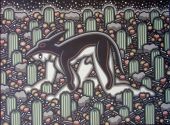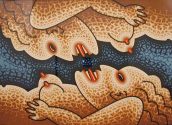“Gordy’s Chimerical World,” New Orleans Art Review
Robert Gordy is a quintessential visionary. A dreamer. An undauntable dweller in that violet-skied, chimerical world of aesthetic fantasy. Rarely has there been much attention given to this facet of his art; it seemed so latent over the years. But his 1981 survey, assembling twenty years of his paintings and drawings into a remarkable cohesive whole, tacitly proclaims that it is the principle facet and cannot be overlooked any longer.



